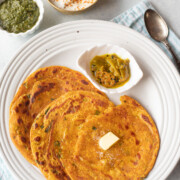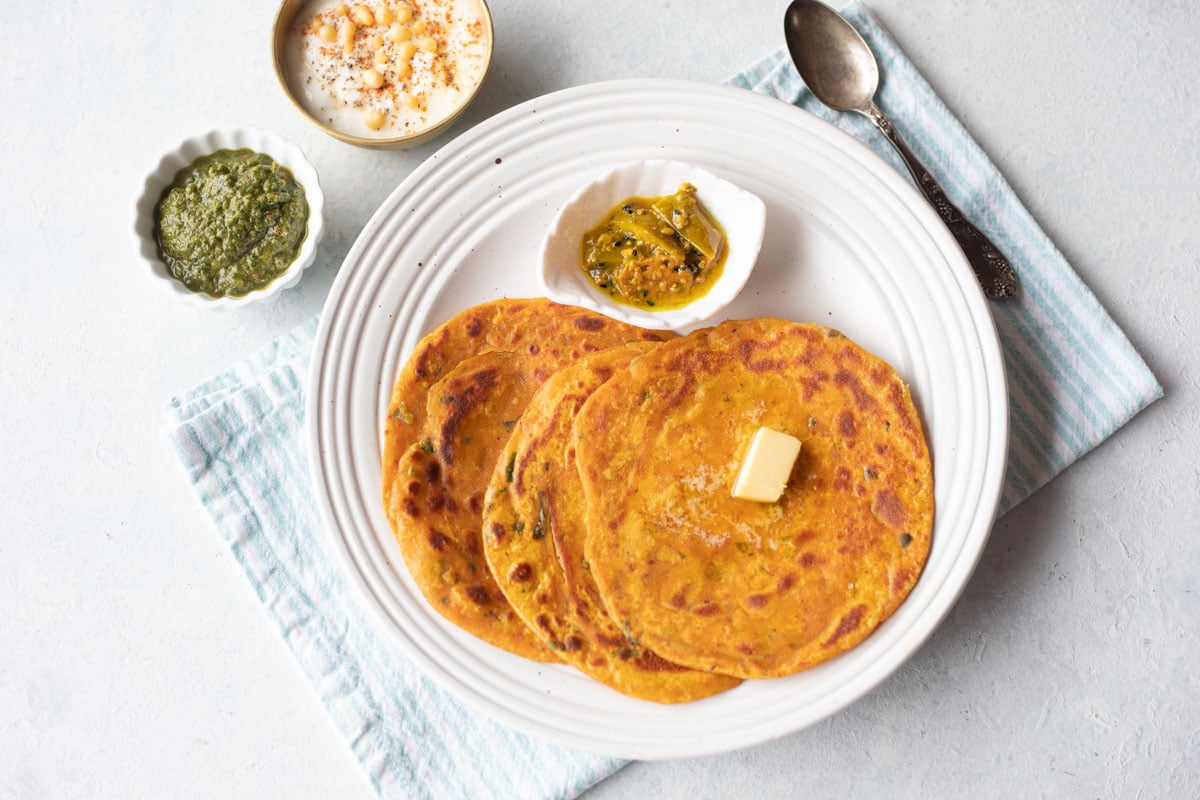
Pumpkin Paratha is an amazing variation of the traditional Indian flatbread; it is soft, healthy, and tasty. To prepare this nutritious flatbread, all we need is whole wheat flour (atta), pumpkin puree, and aromatic spices. You can also make Pumpkin Roti with this recipe!
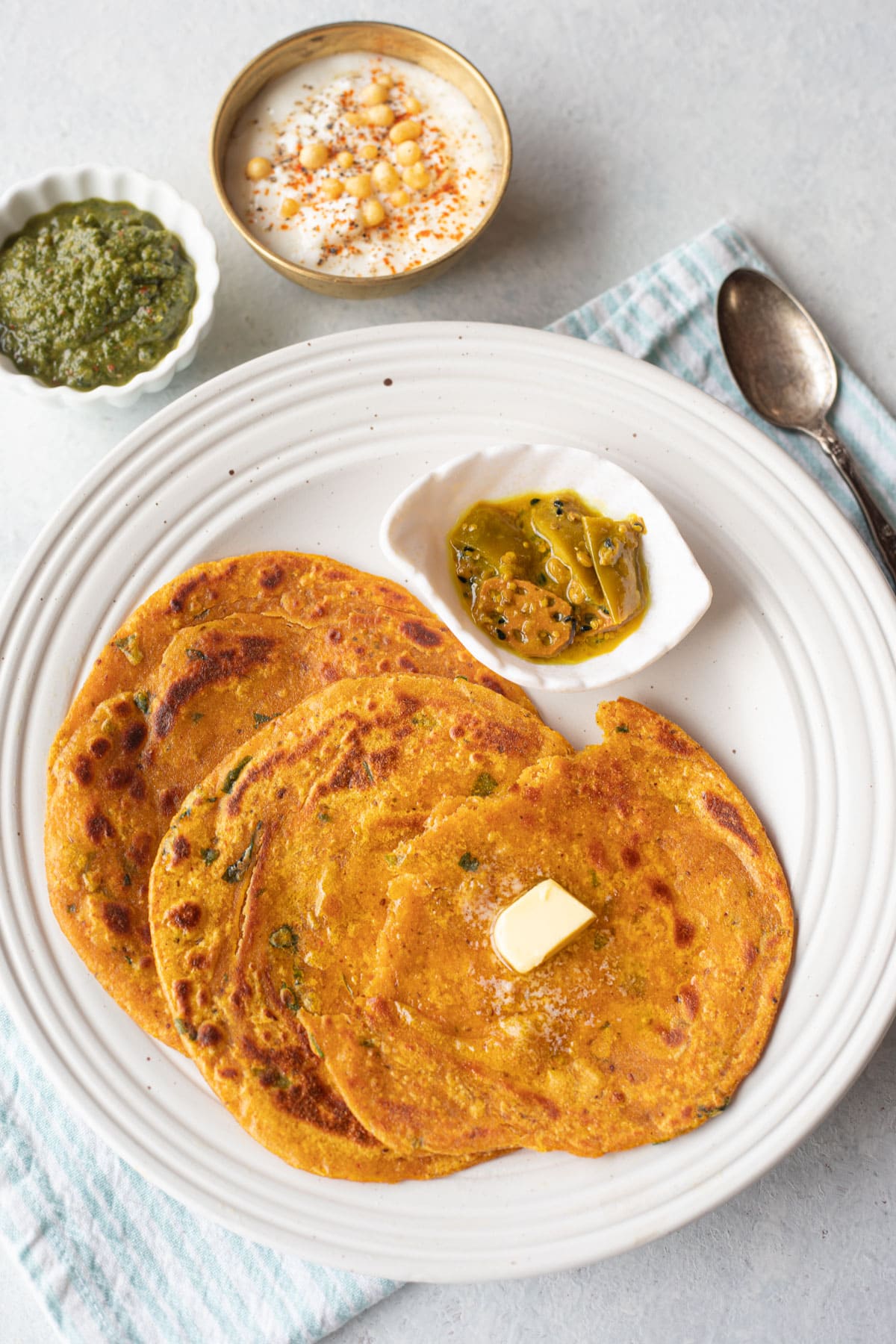
When we have an abundance of pumpkin, I always make pumpkin puree in bulk and store it. It can be stored in the refrigerator for 3 days and also freezes well.
Then, whenever I make dough for roti or paratha, I use pumpkin puree instead of water. This makes the parathas much more nutritious and soft. These parathas are perfect with any curry and also for kids’ lunch boxes.
Parathas are a favorite in my Punjabi home; my kids love aloo paratha, methi paratha, and cheese paratha.
About Pumpkin Paratha & Roti
Pumpkin Paratha is a wholesome and flavorful Indian flatbread that’s as nutritious as it is satisfying. Made from a dough of wheat flour, with the goodness of pumpkin and aromatic spices, it offers a perfect balance of health and taste.
Of course, you can also make roti with the same pumpkin dough. It is called Parangikai Rotti or Chapati in Tamil Nadu in Southern India. You can also make pumpkin puri with this dough. It is called Bhoplache Puri in Marathi.
Pumpkin paratha can be enjoyed as a standalone dish for breakfast or lunch, served with a bowl of yogurt/ raita or a side of chutney for added flavor.
Alternatively, it can be paired with your favorite curry or dal for a complete and satisfying meal.
Ingredients
Pumpkin Puree: Pumpkin puree is made by cooking and blending pumpkin until smooth. It adds moisture, sweetness, and a subtle pumpkin flavor to the paratha dough.
Green Chili Pepper: Finely diced green chili peppers add a bit of heat and fresh, spicy flavor to the paratha dough.
Ginger: Grated ginger adds a warm, pungent flavor to the paratha dough and complements the sweetness of the pumpkin.
Cilantro Leaves: Chopped cilantro leaves contribute a fresh flavor to the paratha dough, adding color and freshness to the dish.
Cumin Powder: Cumin powder has a warm, nutty flavor that adds depth to the paratha dough.
Carom Seeds: Carom seeds have a strong, aromatic flavor. They aid digestion and add a unique aroma to the paratha dough.
Spices: You’ll need salt, turmeric powder, and red chili powder.
Oil or Ghee: A little is added to the dough. It is also used to pan-fry the parathas.
Variations
Grated Pumpkin Paratha: Instead of using mashed pumpkin puree, grate fresh pumpkin and mix it with wheat flour, spices, and other stuff. Grating the pumpkin adds texture to the paratha.
Sweet Pumpkin Paratha: To make it sweeter, add a bit of sugar or jaggery powder to the dough along with pumpkin puree. You can also sprinkle some cinnamon and/or cardamom for extra taste. Serve with yogurt or honey for a yummy dessert-like treat.
Spiced Pumpkin Filling: Instead of mixing pumpkin into the dough, cook the grated or diced pumpkin with onions, garlic, and spices like cumin, coriander, and turmeric. Use this tasty filling to stuff the parathas before rolling them out. It makes the parathas moist and full of flavor.
Making Pumpkin Puree
- Cut the pumpkin into chunks and cook until soft.
- If using an Instant Pot, place a trivet inside and add water to it. Put the pumpkin on the trivet (or directly in the pot). Close the Instant Pot and set it on pressure cook mode for 12 minutes. Let the pressure release naturally.
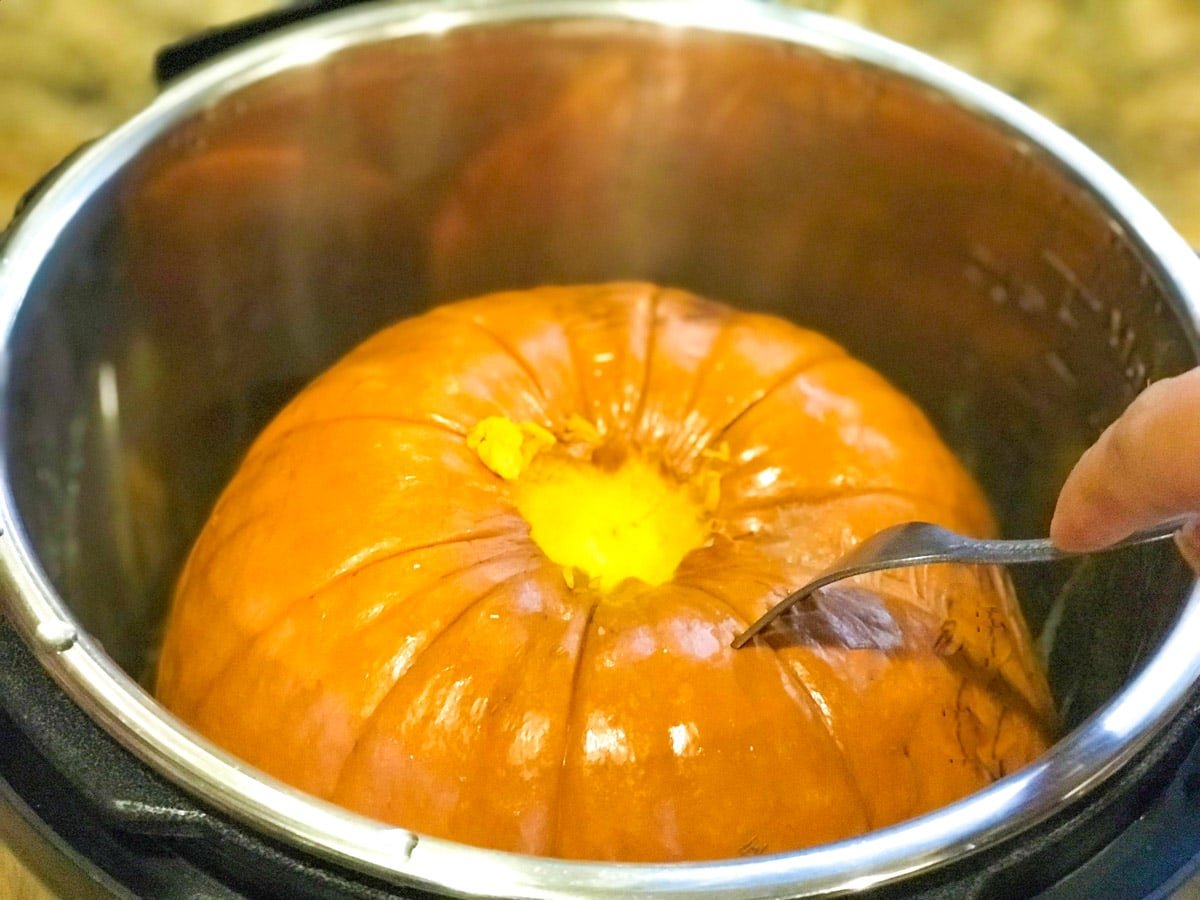
- Once cooled, remove the pumpkin carefully, slice it in half, and scoop out the seeds.
- Scoop the cooked pumpkin out from the skin and add it to a food processor or blender.
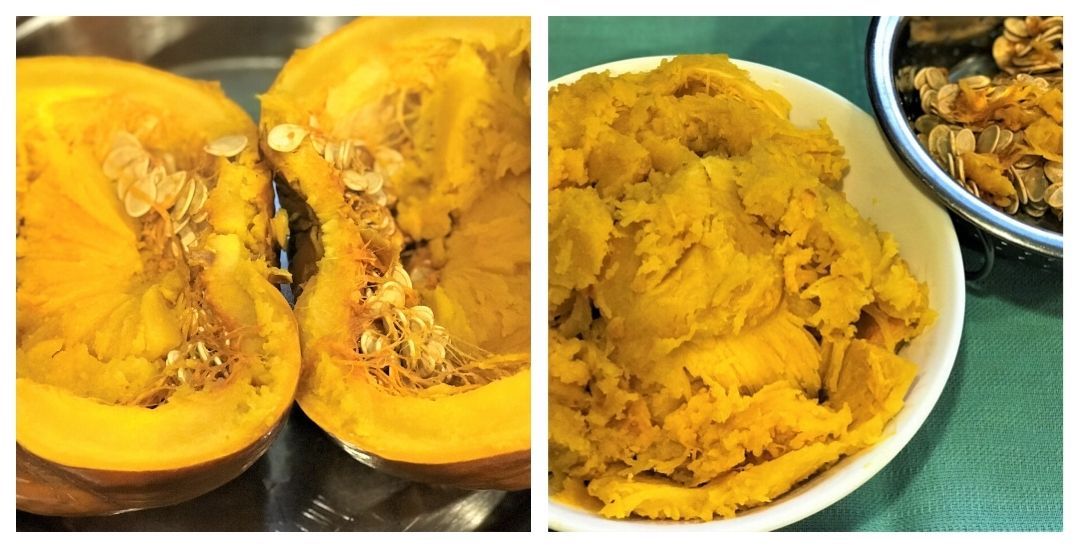
- Add water as needed to achieve a smooth texture. The pumpkin puree is ready.

Making the Dough
- In a large bowl, combine atta (whole wheat flour) with pumpkin puree, chopped green chili, grated ginger, cilantro leaves, salt, turmeric powder, red chili powder, cumin powder, and carom seeds.
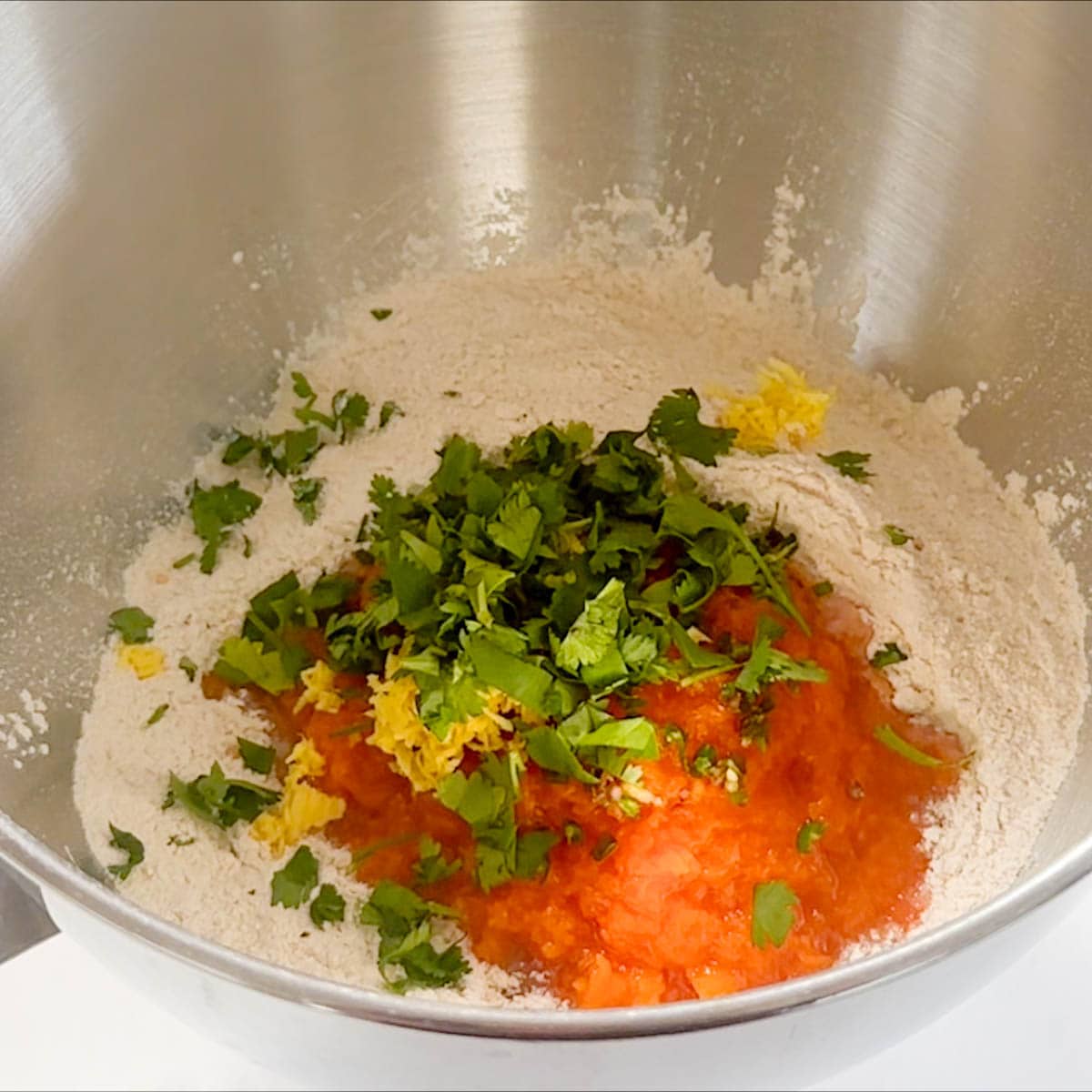
- Knead until a soft, smooth dough forms. Test by pressing a finger into the dough – it should leave an impression.
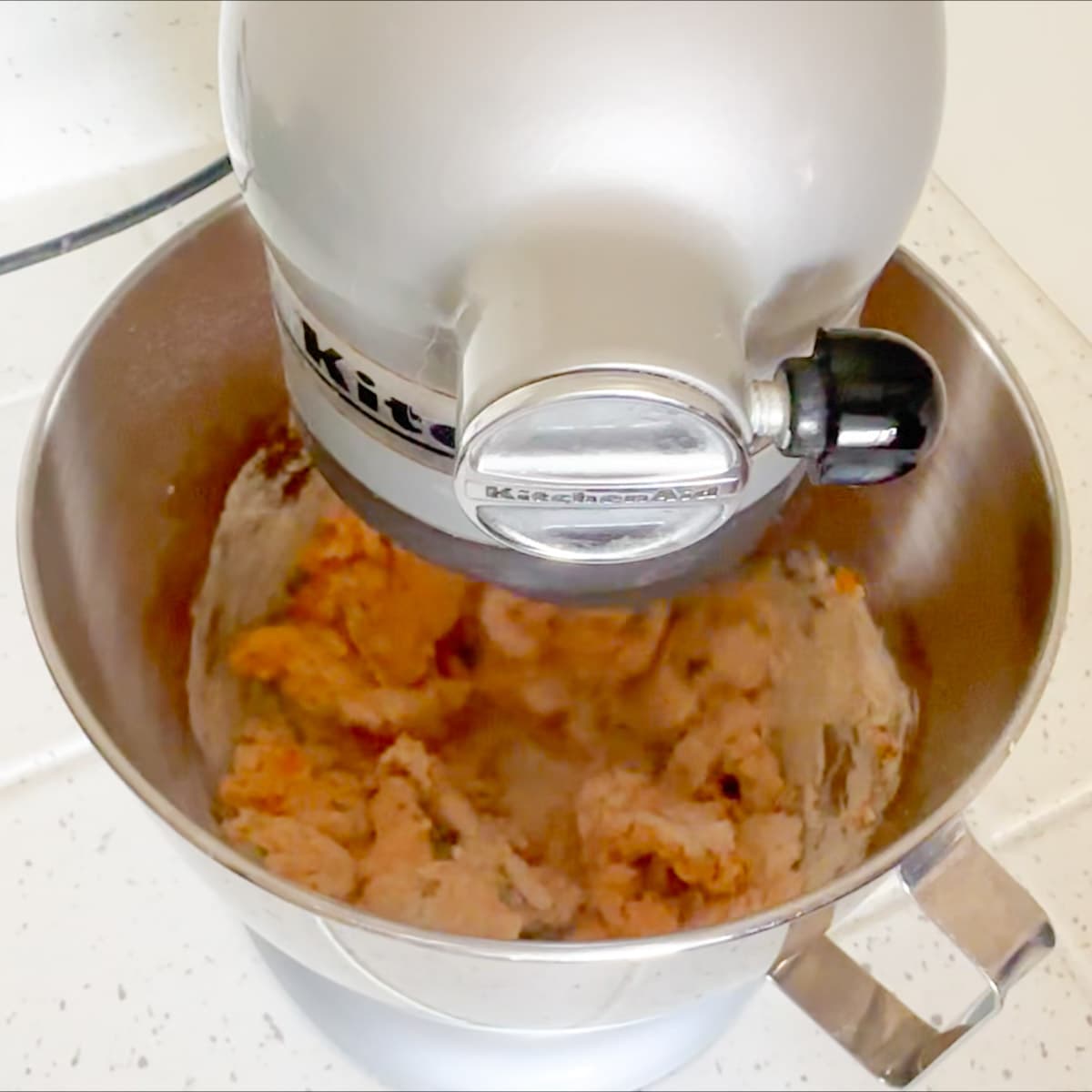
- Alternatively, use a stand mixer with a dough hook attachment. Start on low speed until dough forms, adding water if needed.
- Use your hands to press the dough gently to feel its consistency.
- If the dough feels too dry or crumbly, it may need a little water to soften it and make it easier to work with.
- Aim for a dough that holds together well without being too dry or too wet. It should feel soft to the touch.

How to Make Pumpkin Roti?
- Make small, flat balls from the dough by rolling them between your hands.
- Put a dough ball in dry flour and place it on a flat surface.
- Flatten the dough with a rolling pin to make a circle. Make it about 6 inches in diameter.

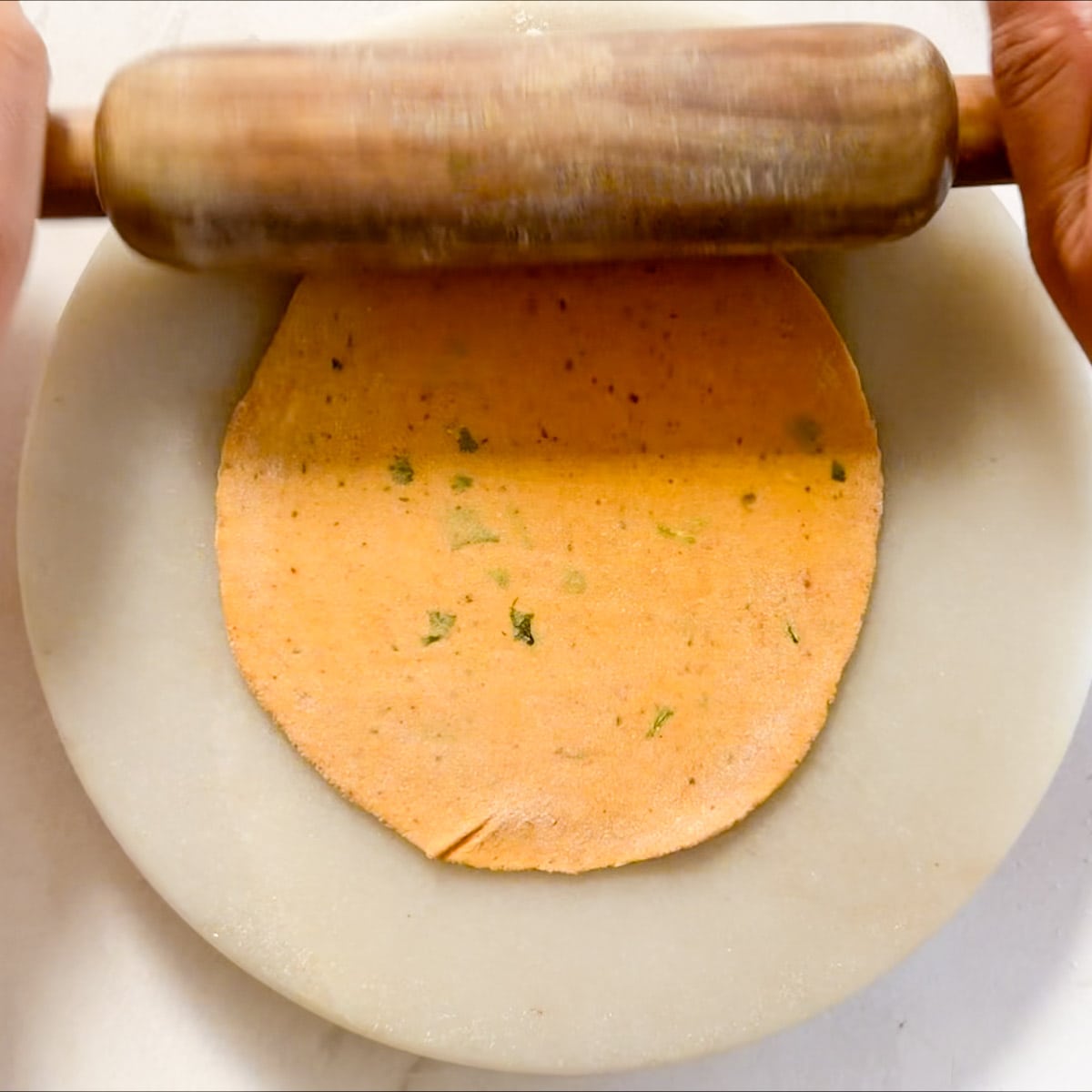
- If you want, you can add a little ghee (butter) and make a cut in the middle before rolling it out.
- Roll out the dough gently with the rolling pin. Turn it a little as you go to make it round.
- Keep adding flour to prevent sticking.
- Don’t press too hard while rolling. Keep it light and gentle.
- Preheat a Tawa (griddle) on medium-high flame. Pick the roti and flip between your palms to remove any extra dry flour. Transfer the roti to the tawa.
- Turn when the color changes and small air pockets form in about 5-10 seconds.

- For the other side, now we want to cook until there are some brown spots on the roti.
- Now, you can cook directly on the flame. Use tongs (chimta) to turn from side to side until the roti puffs.
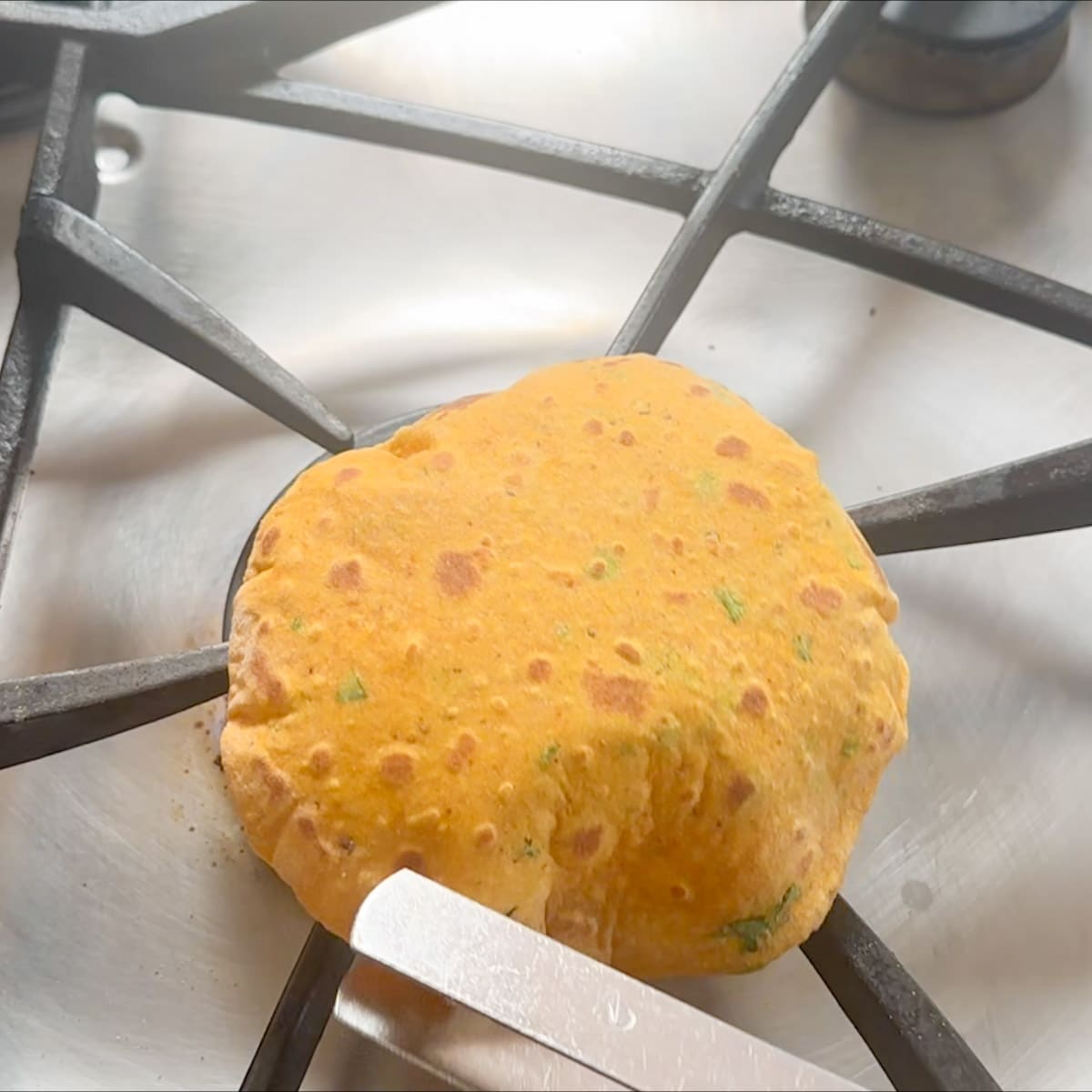
How to Make Pumpkin Paratha?
- Make small, flat balls from the dough by rolling them between your hands.
- Put a dough ball in dry flour and place it on a flat surface.
- Flatten the dough with a rolling pin to make a circle. It should be about 4-5 inches in diameter.
- Add a little ghee or oil, and make a cut in the middle before rolling it out.
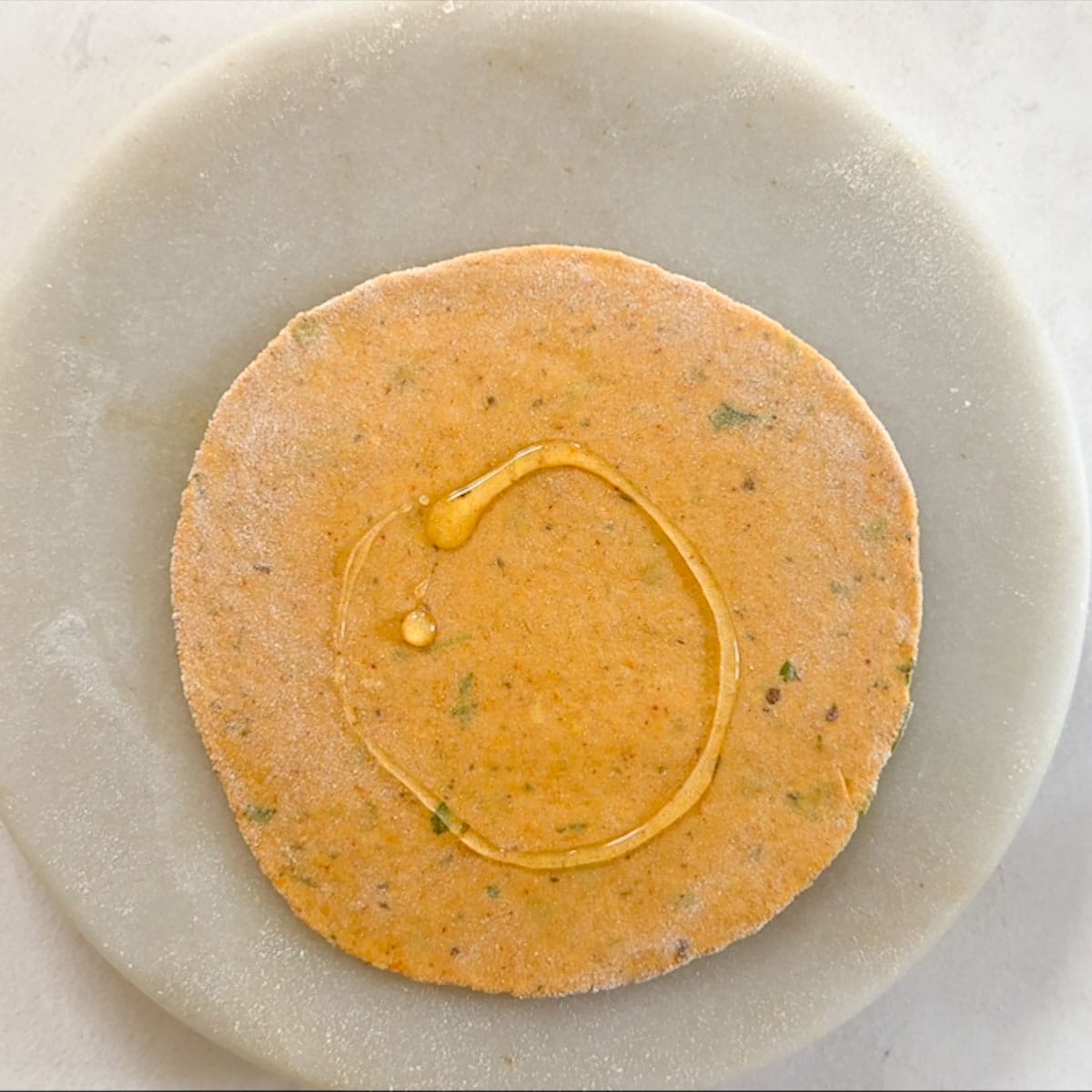
- Roll out the dough gently with the rolling pin. Turn it a little as you go to make it round.

- Keep adding flour to prevent sticking.
- Don’t press too hard while rolling. Keep it light and gentle.
- Heat a skillet or griddle and place a rolled-out paratha on it.
- Cook until small air pockets form and the dough changes color, then flip it.
- Spread ghee or oil on the cooked side and cook until brown spots appear.
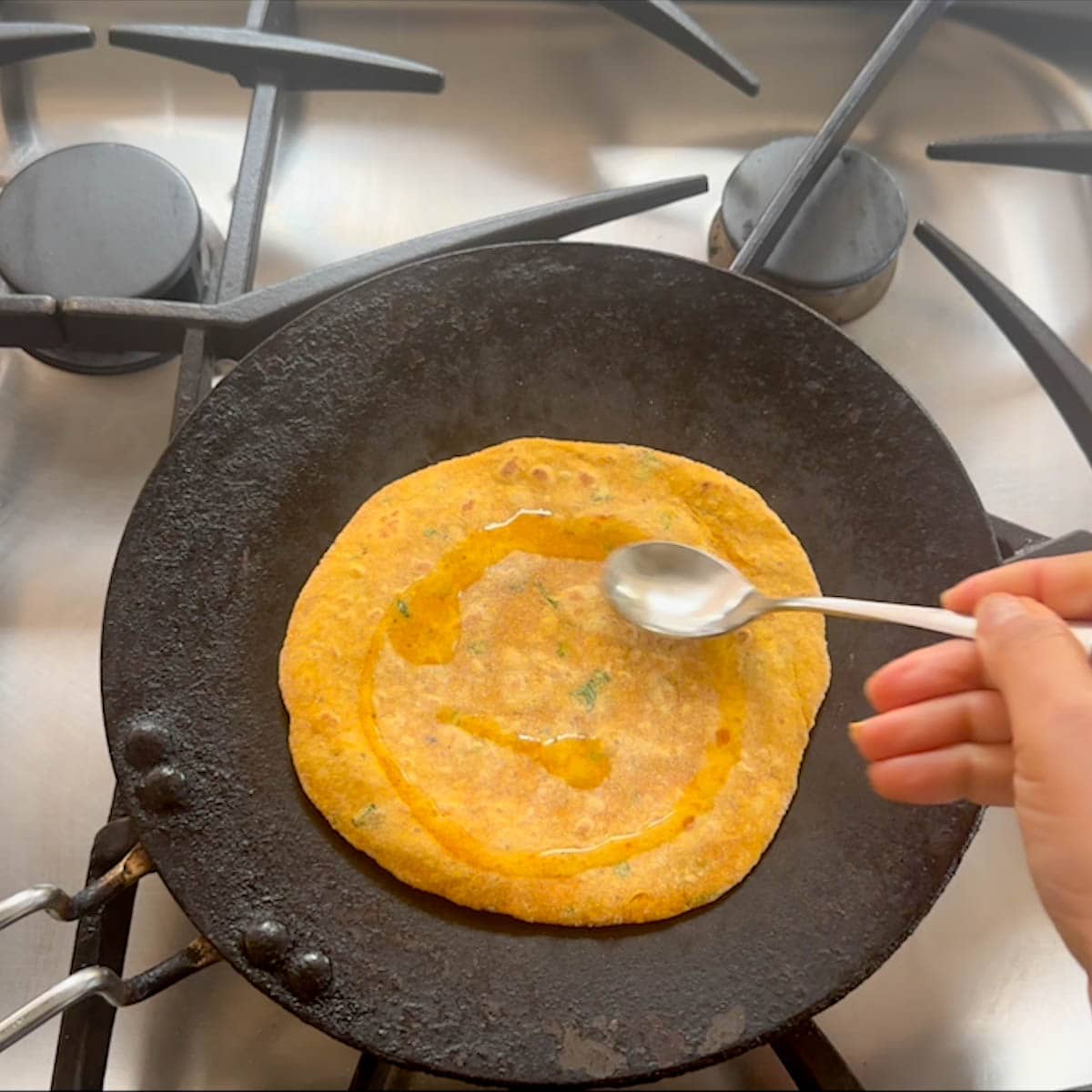
- Flip again, spread ghee/oil, and cook until both sides are evenly browned.
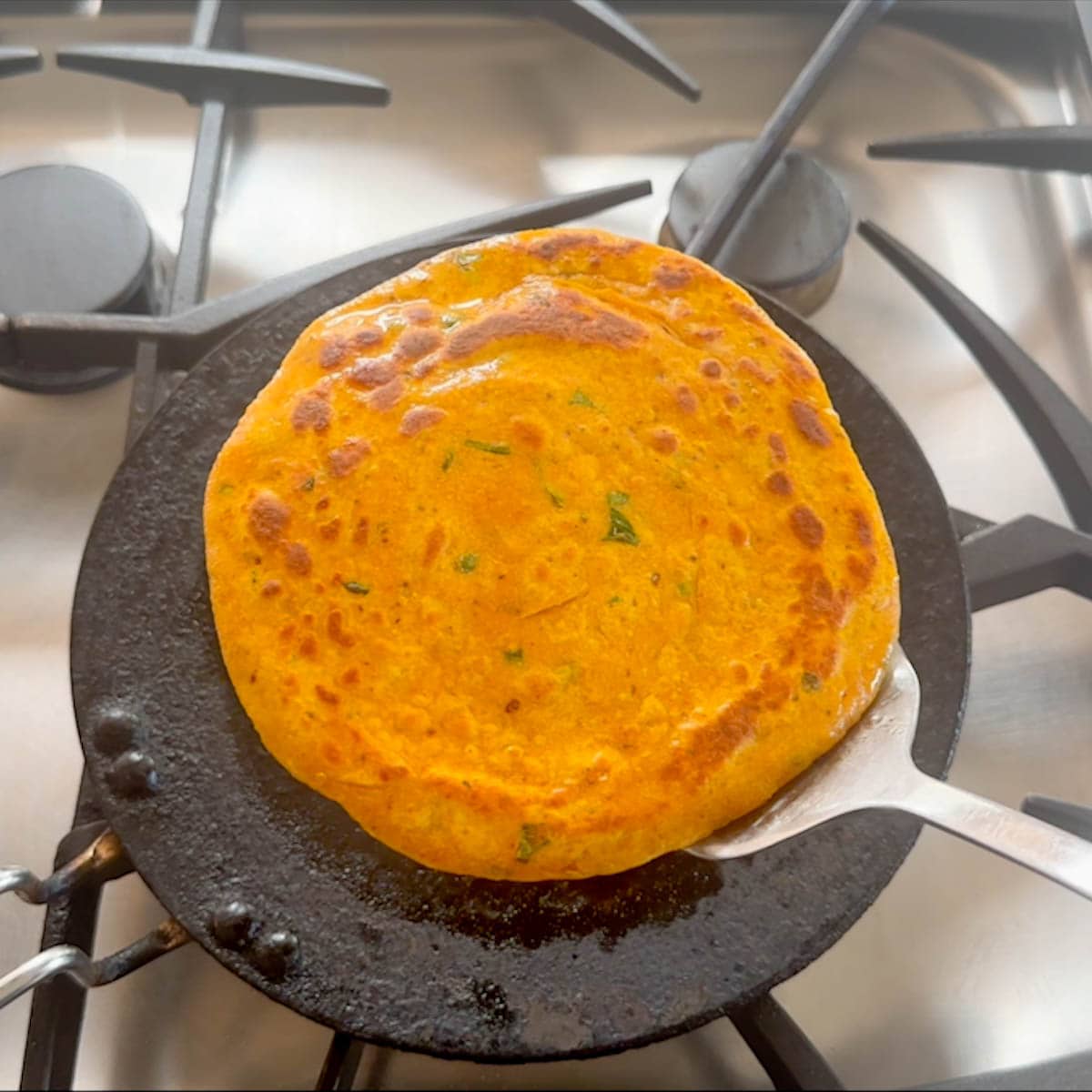
- Serve hot with your favorite sides.

Pro Tips
- Adjust moisture carefully: Balance the amount of pumpkin puree and water while kneading the dough to avoid it becoming too sticky or dry.
- Roll evenly: Use gentle pressure and roll evenly to maintain a consistent thickness throughout, preventing parathas from becoming unevenly thick or thin.
- Preheat skillet: Ensure the skillet or griddle is properly preheated to medium-high heat for even cooking and a golden color without burning.
- Experiment with fillings: Get creative by adding grated paneer, cooked lentils, or other grated vegetables to the dough for added flavor and texture.
What to serve with Pumpkin Paratha?
Pumpkin paratha tastes great with different sides. You can eat it with yogurt or raita such as boondi raita, cucumber raita, or lauki raita for a cooling taste.
Spicy pickles add extra flavor. Chutneys such as mint cilantro chutney are also yummy. If you want a filling meal, enjoy it with a curry or dal.
How to Store Pumpkin Paratha?
- Room Temperature: If you’ll eat them soon, just put them in a closed container or wrap them in foil or a cloth and leave them on the counter.
- Refrigeration: For longer storage, let the parathas cool, then put them in an airtight container or wrap them in foil. They’ll stay good in the fridge for 2-3 days.
- Freezing: To keep them even longer, stack the parathas with parchment paper between each one and freeze them in a bag. They’ll last for 1-2 months this way.
- Reheating: When you’re ready to eat, warm up the parathas in a pan or microwave until they’re hot all the way through.
Make the Dough
-
In a large bowl, combine atta (whole wheat flour), pumpkin puree, green chili, ginger, cilantro leaves, salt, turmeric powder, red chili powder, cumin powder, and carom seeds.
-
Knead to make a soft and smooth dough. Make the dough smooth by kneading it with your fist. Add some water to your hand and knead 2-3 times. When you press your finger against the dough, it should leave an impression. This is the right consistency of the dough.
-
Using a stand mixer or food processor to make dough: Alternatively, you can make the dough using a stand mixer. Use a dough hook attachment, and start the mixer at the lowest speed. In a couple of minutes, the dough will start coming together. The dough should be soft and pliable. Add a few teaspoons of water as needed to make a soft dough.
-
Cover with a damp cloth or plastic wrap and let the dough rest for at least 15 minutes and up to 30 minutes.
-
Keep the rolling board and rolling pin ready. Keep a bowl of dry flour and a bowl of ghee to apply to the roti once it is ready. You want to roll and cook the roti at the same time so the rolled dough does not become dry.
Making Pumpkin Roti
-
Make small balls from the dough by rotating between your palms. Make the ball a bit flat. Dip a ball in dry flour, place it on the marble or wooden base (chalka) and roll with the rolling pin.
-
Do not apply too much pressure while rolling. Apply equal pressure on all sides while rolling. When you roll with gentle hands, the dough flattens and moves in circles with the rolling pin. You can also turn the roti with your hands at 90 degrees multiple times while rolling so that it forms a circle. Apply dry dough about halfway through on both sides and roll again.
-
Preheat a Tawa (griddle) on medium-high flame. Pick the roti and flip between both palms to remove any extra dry flour. Transfer roti on the tawa.
-
Turn when the color starts changing and small air pockets form in about 5-10 seconds. For the other side, now we want to cook until there are some brown spots on the roti.
-
Now, you can cook directly on the flame. Use tongs (chimta) to turn from side to side until the roti puffs. Take the roti, place it on a paper towel (or a thin cloth) on a plate, and apply ghee.
Making Pumpkin Paratha
-
Make balls from the dough by rotating between your palms. The balls will be the size of a golf ball, slightly larger in size than roti. Make the ball a bit flat. Dip a ball in dry flour, place it on the marble or wooden base (chakla), and roll with the rolling pin.
-
(Optional step) Roll into a circle of about 4 inches in diameter. Spread some ghee on the dough. Make a cut up to the center of the circle, using your fingers. Then start rolling on one side. Take the roll into your hand and flatten it.
-
Dip again in dry flour and start rolling using the rolling pin. Do not apply too much pressure while rolling. Apply equal pressure on all sides while rolling. When you roll with gentle hands, the dough flattens and moves in circles with the rolling pin. You can also turn the paratha with your hands at 90 degrees multiple times while rolling so that it forms a circle. Apply more flour if required while rolling.
-
Heat the tawa (skillet or griddle). Place the rolled paratha on the hot tawa. Cook until you start seeing small air pockets and the color of the dough starts to change.
-
With a flat spatula, flip the paratha and top with ghee just enough to make the surface greasy (about ½ teaspoon). With the back of a spoon, spread the ghee or vegetable oil evenly over the paratha. Now, we want to cook until there are some brown spots on the paratha.
-
Flip the paratha and top with ghee/oil on the other side. Spread it evenly over the surface. Cook until there are brown spots while pressing gently with the spatula.
-
Spread ghee/ oil on the second side and press the edges of the paratha till it is evenly brown and well cooked.
-
When both sides have golden brown spots, transfer the paratha to a plate lined with a paper towel.
-
Repeat these steps till all the parathas are cooked. You can keep parathas in an insulated container or in a roti basket wrapped in a towel. This will ensure they stay warm by the time you are ready to eat. Serve hot with white butter, pickle, raita or a cup of hot chai.
Calories: 117kcalCarbohydrates: 25gProtein: 4gFat: 1gSaturated Fat: 0.2gPolyunsaturated Fat: 0.4gMonounsaturated Fat: 0.1gSodium: 314mgPotassium: 180mgFiber: 4gSugar: 1gVitamin A: 4814IUVitamin C: 2mgCalcium: 20mgIron: 2mg
Discover more from reviewer4you.com
Subscribe to get the latest posts to your email.
